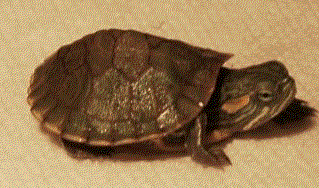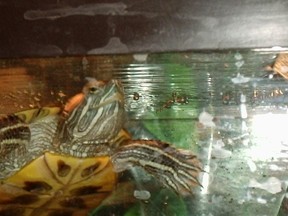Scientific Classification:Trachemys Scripta Elegans
Common Name: Red-Eared Slider or Florida Turtle
Geographical: Native to United States(south).They can now be found all over the world. The Red-Eared Sliders have been introduced by people who bought them as pets and when they decided they didn'tt want to keep them anymore they released them in freedom. That is a big problem. For example: in southern Europe Red-Eared Slider competes for survival against the cistude of Europe. And cistude is now in danger of extinction. Please, DO NOT RELEASE YOUR TURTLE IN THE WILD.
Size: They can grow up to 30cm(11.8 inches). Male sliders grow between 6-10 inches and females between 10-12 inches.
Life span: In captivity they can live up to 40-50 years. Some individuals have lived more than 100 years, but only if you have provided the proper care for them. In the wild they can get 20 years.
Description: Male res have long, thick tales and they also have elongated front claws. They tend to be more brightly colored than females and are smaller. Females have short front nails and short, skinny tails. They are larger and more darkly colored than males. All RES have a reddish patch of skin behind their ear area. The toes on their legs are connected by a membrane(both,male and female). RES are usually good natured turtles. They enjoy basking. Although they are usually docile, they will bite if provoked.
Breeding: Females can produce up to three clutches of 4 to 23 eggs in a single year. Female: the cloaca is located closer to the carapace than in males.
Habitat: Red-Eared Sliders live in ponds, streams, rivers and lakes. They need fresh water. They prefer calm waters with soft bottoms and dense vegetation. They need a freshwater aquarium with a warm dry land area for basking and a large warm water area for swimming.
Preferred Temperature: Water area: 21.1°C-26.6°C(70°F-80°F). Land area:
28°C-30°C(80°F-90°F).
Food habits: Omnivores. They prefer non-vegetarian food when young.




